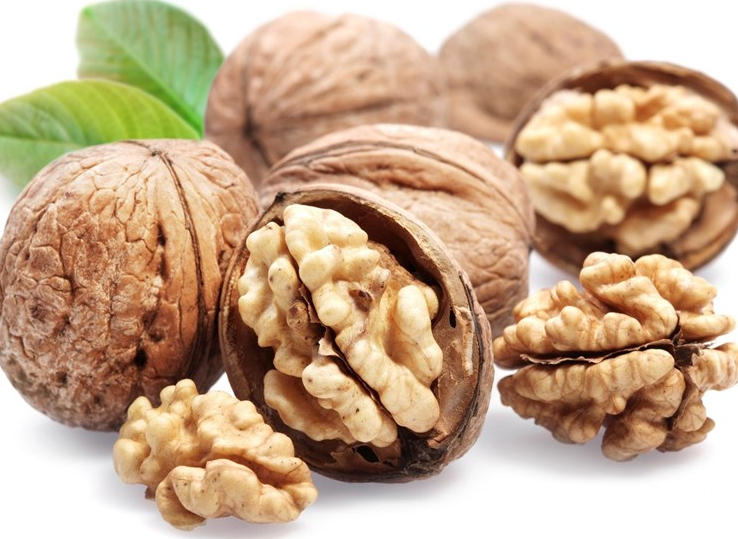Walnuts are a type of tree nut that have been consumed by humans for thousands of years. They are a nutrient-dense food that provide a variety of health benefits, including reducing inflammation, improving heart health, and boosting brain function. In recent years, the popularity of walnuts has increased due to their potential role in preventing chronic diseases.
5 Proven Health Benefits of Walnuts :
Walnuts Are the ONLY Nut with Omega 3 Fats :
In this article, we will explore the properties of walnuts and their potential health benefits. We will discuss the nutritional value of walnuts, including their high levels of healthy fats, protein, and fiber. Additionally, we will examine the various bioactive compounds found in walnuts that may contribute to their health benefits.

1. Introduction
1.1. Historical Background of Walnuts
Walnuts (Juglans regia), also known as Persian or English walnuts, have a long and rich history that dates back thousands of years. They are believed to have originated in the mountainous regions of Central Asia, specifically in present-day Iran and the surrounding areas. As trade routes expanded, walnuts spread to different parts of the world, including Europe, North Africa, and East Asia. Ancient Greeks and Romans were among the first civilizations to recognize the nut’s nutritional value, and they used walnuts for both culinary and medicinal purposes.
Throughout history, walnuts have been highly valued not only for their taste and nutritional content but also for their use in various traditional remedies. In traditional Chinese medicine, for example, walnuts were considered a “warming” food that could strengthen the kidneys and nourish the brain. In Ayurvedic medicine, they were used to treat various conditions, including respiratory disorders, digestive issues, and nervous system disorders.
1.2. Walnut Cultivation and Production
Walnut trees are deciduous and can grow up to 25-35 meters (80-115 feet) in height. They thrive in temperate climates with well-drained, fertile soil, and sufficient sunlight. Walnut trees can take up to 10 years to reach full maturity and begin producing nuts, but once they do, they can produce for several decades.
Today, walnuts are cultivated in many countries worldwide, with China, the United States, Iran, and Turkey being the top producers. California, in particular, is responsible for a significant portion of the United States’ walnut production, with its Mediterranean climate providing ideal growing conditions for the nut.
Walnut cultivation involves several stages, including planting, irrigation, fertilization, pruning, and pest management. Harvesting typically takes place between late September and early November, depending on the region’s climate. Once harvested, walnuts are cleaned, dried, and sorted before they are shelled and processed for consumption.
As global demand for walnuts continues to grow, advances in cultivation techniques and breeding have resulted in improved varieties with higher yields, better resistance to diseases and pests, and enhanced nutritional qualities.

2. Nutritional Composition of Walnuts
2.1. Macronutrients
Walnuts are nutrient-dense, and they are particularly rich in healthy fats, including polyunsaturated fatty acids (PUFAs) and monounsaturated fatty acids (MUFAs). A significant proportion of the PUFAs in walnuts is alpha-linolenic acid (ALA), an essential omega-3 fatty acid that plays a crucial role in maintaining overall health. Additionally, walnuts are a good source of protein, with approximately 15% of their total weight coming from this essential macronutrient. They also contain dietary fiber, which aids in digestion and promotes a healthy gut microbiome.
2.2. Vitamins and Minerals
Walnuts are packed with various vitamins and minerals that contribute to a healthy diet. They are an excellent source of vitamin E, particularly in the form of gamma-tocopherol, which functions as a potent antioxidant. Walnuts also contain significant amounts of B vitamins, including thiamine (B1), riboflavin (B2), niacin (B3), pantothenic acid (B5), pyridoxine (B6), and folate (B9). These B vitamins are essential for energy production, red blood cell formation, and proper nervous system function.
Among the minerals found in walnuts are magnesium, phosphorus, potassium, calcium, iron, and zinc. Magnesium plays a crucial role in regulating blood pressure and maintaining bone health, while phosphorus is vital for bone and teeth formation. Potassium helps maintain proper fluid balance and supports heart function, while calcium is essential for bone health and nerve signaling. Iron is necessary for red blood cell production, and zinc contributes to immune system function and wound healing.
2.3. Phytonutrients and Antioxidants
Walnuts are rich in various phytonutrients and antioxidants that offer numerous health benefits. One of the most notable is ellagic acid, a polyphenol compound found in high concentrations in walnuts. Ellagic acid has been shown to have anti-inflammatory, anti-cancer, and anti-viral properties. Other polyphenols present in walnuts include catechin, epicatechin, and gallic acid, which all have antioxidant and anti-inflammatory effects.
Additionally, walnuts contain a range of other antioxidant compounds, such as melatonin, carotenoids, and selenium. Melatonin is a hormone that regulates sleep and has potent antioxidant properties. Carotenoids, including lutein and zeaxanthin, support eye health and may help prevent age-related macular degeneration. Selenium, a trace element, acts as an antioxidant and supports immune system function.
Overall, the nutritional composition of walnuts makes them a valuable addition to a balanced diet, providing essential nutrients and health-promoting compounds.

3. Health Benefits of Walnuts
3.1. Cardiovascular Health
One of the most well-known health benefits of walnuts is their ability to support cardiovascular health. The high content of omega-3 fatty acids, particularly alpha-linolenic acid (ALA), helps to reduce inflammation and improve blood lipid profiles. Regular consumption of walnuts has been associated with decreased levels of LDL cholesterol (the “bad” cholesterol) and increased levels of HDL cholesterol (the “good” cholesterol). Furthermore, walnuts contain antioxidants such as vitamin E and polyphenols, which protect against oxidative damage to blood vessels and help prevent atherosclerosis.
3.2. Brain Health and Cognitive Function
Walnuts are often referred to as “brain food” due to their unique nutrient composition that supports cognitive health. The omega-3 fatty acids found in walnuts are crucial for maintaining brain cell membrane integrity and facilitating communication between brain cells. Additionally, the vitamin E and polyphenols in walnuts have antioxidant properties that protect brain cells from oxidative stress and inflammation, which can contribute to age-related cognitive decline. Regular consumption of walnuts has been linked to improved memory, better cognitive performance, and a reduced risk of neurodegenerative diseases such as Alzheimer’s.
3.3. Anti-inflammatory Effects
Inflammation is a natural immune response that, when chronic or excessive, can contribute to various health conditions. Walnuts contain numerous compounds with anti-inflammatory properties, including omega-3 fatty acids, polyphenols, and antioxidants. These compounds help to modulate the inflammatory response, reducing the risk of chronic inflammation and its associated health issues, such as heart disease, diabetes, and cancer.
3.4. Cancer Prevention
Research suggests that the consumption of walnuts may have protective effects against certain types of cancer, including breast, prostate, and colorectal cancer. The specific compounds in walnuts that contribute to this effect include ellagic acid, which has been shown to inhibit cancer cell growth and induce apoptosis (cell death) in cancer cells. Additionally, the high content of antioxidants in walnuts helps to neutralize free radicals, which can cause cellular damage and contribute to cancer development.
3.5. Weight Management and Metabolic Health
Although walnuts are calorie-dense due to their high fat content, they have been linked to better weight management and improved metabolic health. The healthy fats, protein, and fiber found in walnuts can help promote feelings of fullness and satiety, reducing overall calorie intake. Moreover, research has shown that incorporating walnuts into a balanced diet can improve insulin sensitivity and reduce the risk of developing type 2 diabetes.
3.6. Digestive Health
The dietary fiber found in walnuts is essential for maintaining a healthy digestive system. Fiber helps to regulate bowel movements, prevent constipation, and promote the growth of beneficial gut bacteria. A healthy gut microbiome is crucial for overall health, including immune function, mental health, and the prevention of various diseases.
3.7. Skin and Hair Health
Walnuts provide several nutrients that are beneficial for skin and hair health, including vitamin E, biotin, and omega-3 fatty acids. Vitamin E acts as an antioxidant, protecting skin cells from oxidative damage and promoting skin healing. Biotin, a B vitamin, is essential for maintaining healthy hair and nails, while omega-3 fatty acids help to reduce inflammation and promote skin hydration.
3.8. Bone Health
Walnuts contain several nutrients that are important for maintaining strong and healthy bones, including calcium, magnesium, and phosphorus. Calcium is crucial for bone mineralization, while magnesium and phosphorus play key roles in bone metabolism and structure. Regular consumption of walnuts may contribute to better bone health and a reduced risk of osteoporosis.

4. Incorporating Walnuts into a Healthy Diet
4.1. Recommended Intake and Serving Sizes
To reap the health benefits of walnuts, it is important to consume them in moderation as part of a balanced diet. A typical recommended serving size is about 1 ounce (28 grams) or approximately a small handful, which contains around 190 calories, 18 grams of fat, 4 grams of protein, and 2 grams of fiber. Consuming 1-2 servings of walnuts per day is generally considered safe and beneficial for most individuals.
4.2. Recipe Ideas and Cooking Tips
Walnuts are a versatile ingredient that can be incorporated into various dishes, from sweet to savory. Here are some ideas on how to include walnuts in your diet:
As a snack: Eat a handful of raw or roasted walnuts as a nutritious and satisfying snack.
In salads: Add chopped walnuts to green salads, grain salads, or fruit salads for added crunch and flavor.
In yogurt or oatmeal: Mix walnuts into yogurt or oatmeal for a delicious and nutrient-dense breakfast.
In baked goods: Use walnuts in recipes for muffins, cookies, bread, or cakes for added texture and nutrition.
In main dishes: Incorporate walnuts into vegetarian dishes, such as veggie burgers or nut roasts, or use them as a topping for pasta, rice, or vegetable dishes.
In sauces and spreads: Blend walnuts into pesto, hummus, or other spreads and sauces for added creaminess and depth of flavor.
When cooking with walnuts, it is essential to store them properly to maintain their quality and prevent them from turning rancid. Keep walnuts in an airtight container in a cool, dark place, or store them in the refrigerator or freezer to extend their shelf life.
4.3. Nut Allergies and Precautions
It is important to note that some individuals may be allergic to walnuts and other tree nuts. Symptoms of a walnut allergy can range from mild, such as itching or rash, to severe, including difficulty breathing or anaphylaxis. If you suspect that you or someone you know has a nut allergy, it is essential to consult with a healthcare professional for proper diagnosis and guidance.
In addition to allergies, some individuals may experience gastrointestinal discomfort or bloating after consuming walnuts, particularly if they are not used to a high-fiber diet. To minimize this risk, start by incorporating small amounts of walnuts into your diet and gradually increase your intake over time.

5. Environmental and Social Impact of Walnut Production
5.1. Sustainability and Climate Considerations
Walnut production, like any other agricultural endeavor, has environmental implications. Some of the key concerns related to walnut farming include water usage, pesticide application, and the carbon footprint associated with transportation and processing.
Walnut trees have relatively high water requirements, which can be a concern in areas where water scarcity is an issue. Adopting sustainable farming practices, such as drip irrigation and water recycling, can help minimize water use and reduce the environmental impact.
Pesticides are often used in walnut production to manage pests and diseases. However, excessive pesticide use can harm the environment and potentially impact human health. Integrated pest management practices, which combine biological, cultural, and chemical methods, can help reduce pesticide reliance and protect the ecosystem.
The transportation and processing of walnuts, especially when they are grown in one country and consumed in another, contribute to their carbon footprint. To minimize this impact, consumers can choose locally grown walnuts or support producers that use sustainable practices and energy-efficient processing methods.


